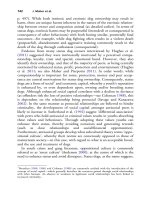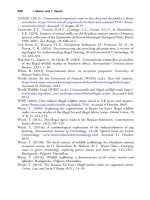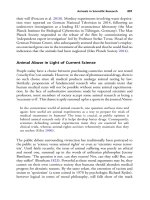The palgrave international handbook of a 125
Bạn đang xem bản rút gọn của tài liệu. Xem và tải ngay bản đầy đủ của tài liệu tại đây (37.63 KB, 1 trang )
Animal Hoarding
115
disagree with a human’s interpretation of how they feel or what they want
but the hoarder can believe that animals feel and think exactly like them and
want what they want, whether or not they actually do.
Other Factors
Genetics
Family studies show that object hoarding is more common among first-degree
relatives of people with hoarding when compared with non-hoarding controls.
Pedigree and twin studies suggest that hoarding has a strong genetic component and complex pattern of inheritance. However, most of these studies have
involved subjects with OCD or other disorders in addition to hoarding
symptoms. Currently, there is a lack of replication of previous genetic studies
(Hirschtritt and Mathews 2014). There have been no studies to date specifically looking at possible genetic contributors specific to animal hoarding.
Neurophysiology
Pathological hoarding behavior potentially involves disruption of brain
mechanisms associated with decision-making, general cognitive function,
impulsivity, assignment of emotional significance to possessions and anxiety
associated with decision-making or separation from such objects or animals.
The earliest studies of brain function in hoarding patients (Saxena et al.
2004) found that, compared to non-hoarding OCD patients, OCD patients
with compulsive hoarding had significantly lower glucose metabolism in the
dorsal anterior and posterior cingulate gyrus. Contemporary studies continue
to elucidate other brain regions associated with hoarding symptoms, (Slyne
and Tollin 2014), but there have, as yet, been no analyses specific to animal
hoarding. Recent work has demonstrated how the pro-social hormone oxytocin increases in both dogs and people with certain forms of contact, so it is
possible that there may eventually be a neurophysiological explanation for
animal hoarding (Beetz et al. 2012; Nagasawa et al. 2015).
Infectious Disease/ Parasites
There have been periodic media reports drawing a potential connection between
hoarding behavior and infection with the protozoan parasite Toxoplasma gondii
commonly associated with cats and cat feces (Gibson 2015). The specific









